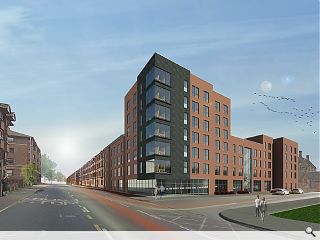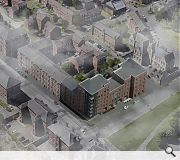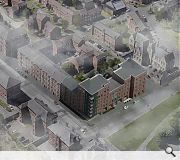Springburn lays public halls ghost to rest with new housing
January 9 2018
North Glasgow Homes and Chameleon have brought forward a design for 49 homes above twin ground floor commercial units on the corner of Keppochill Road and Millarbank Street in Springburn.Previously site of the B-listed Springburn Public Halls, demolished over Christmas 2012, the infill housing will abut a surviving line of tenements rising to an elevated seven storey corner element.
Formed from red brick with areas of zinc cladding the scheme seeks to bookend the corner elevation with a rear amenity space offering space for parking and refuse.
Chameleon observed: “Where the building meets the existing tenement on KeppochhillRoad the design is in keeping with a traditional close layout. The proposed elevation picks up the prominent levels from the existing elevation to ensure a harmony along the street façade, the existing ridge height is also maintained.”
The Edwardian Baroque public halls were demolished five years ago over the course of two days after the property was deemed a health and safety risk by Glasgow City Council.
|
|
9 Comments
#1 Posted by KMCA on 9 Jan 2018 at 11:26 AM
'Surviving' neighbours? Blimey.
#2 Posted by Graeme McCormick on 9 Jan 2018 at 12:41 PM
Isnt it time that there is a policy to include oem green landscaping to the front of all housing developments to soften the starkness of so much of our urban landscape and reduce the carbon footprint? The view row of old or new tenements is pretty raw particularly when the architectural merit is hard to find.
#3 Posted by The Flâneur on 9 Jan 2018 at 14:22 PM
Couldn't agree more Graeme.
Though I am very impressed by Collective’s new development for Sanctuary HA in Anderston, which has helped reintroduce the tenemental scale and repair the urban enclosure, which is so characteristic of Glasgow’s sense of place, to St Vincent Street, some street trees in the front gardens addressing St Vincent would have done wonders for softening the architecture.
The same applies to the various developments now lining Kelvinhaugh Street. While one of the 1990s developments did manage to include some street trees to break up parking bays none of the recent developments have thereby giving the street a harsher urban character than is necessary. And yet the trees look great, help with the climate, introduce a softer more domestic scale and are a mark of civilisation - what is not to like?
Why do cities such as Berlin do this as a matter of course and yet Glasgow finds it so difficult?
Though I am very impressed by Collective’s new development for Sanctuary HA in Anderston, which has helped reintroduce the tenemental scale and repair the urban enclosure, which is so characteristic of Glasgow’s sense of place, to St Vincent Street, some street trees in the front gardens addressing St Vincent would have done wonders for softening the architecture.
The same applies to the various developments now lining Kelvinhaugh Street. While one of the 1990s developments did manage to include some street trees to break up parking bays none of the recent developments have thereby giving the street a harsher urban character than is necessary. And yet the trees look great, help with the climate, introduce a softer more domestic scale and are a mark of civilisation - what is not to like?
Why do cities such as Berlin do this as a matter of course and yet Glasgow finds it so difficult?
#4 Posted by Keppochill wan on 11 Jan 2018 at 09:00 AM
grim.....
#5 Posted by Landschafter on 11 Jan 2018 at 12:32 PM
Graeme / Flâneur, this requires vision that goes beyond the building line. All too often we see landscape crammed into the measliest spaces, to satisfy a planning condition or “give a bit of greenery”. The reason that the likes of Berlin do it so successfully is that value is given to landscape and its ability to provide inviting and useable space that compliments the architecture. Too often we’re seeing a DIY job on the landscape, which inevitably involves chucking down some turf on compacted ground, with a couple of 4th rate trees lobbed in for effect. It can be done, but landscape needs to be integral to the project, there’s plenty of examples where this has been done successfully, it’s cringeworthy when opportunities are being missed or ignored.
#6 Posted by Decocowlairs on 20 Mar 2018 at 12:48 PM
Whilst I am pleased to hear the land may be put to good use. There is a huge opportunity to incorporate the Old School in Gourlay St. into any new build. I agree wholeheartedly with the comments about landscaping the area around the build. I would love to see the statues that were removed from the old Public Halls being incorporated somewhere into the new development.
#7 Posted by C Tavendale on 10 Apr 2018 at 09:39 AM
Is it not time some thought was given to sprucing up some of the old sandstone building ,and surrounding's some of them are looking like slums ,and when renovated ,look full of character
#8 Posted by Beth on 6 Apr 2019 at 12:09 PM
I don't live in the flats but looks like it's going to block a lot of natural light to existing properties! And the park wasn't park of the demolished halls so why is this being built on? Let's just cram more housing into an area with crap amenities. Bravo!
#9 Posted by Ruth on 24 Oct 2019 at 19:20 PM
feeling heartbroken at the loss of light and total loss of skyline to the groundfloor flat I have just moved in, directly opposite that towering development. How can it be allowed to build so tall at the corner end of the development? Also the proposal or plan for the historic statues of the original Halls to be stuck on now at the end of the glass facade is tasteless and inapprobriate esthetically. I totally echo what others say above at the lack of respect for green and spaces as intrinsically valued as part of urban design. 49 Keppochhill road another example of non organic botch job of urban architecture failing to make Glasgow proud.
Post your comments
Back to January 2018
Like us on Facebook
Become a fan and share
News Archive
Search News
Features & Reports
For more information from the industry visit our Features & Reports section.





